#Sage and Port Sautéed Chestnuts
Text
Maple Cream of Mushroom Soup (Vegetarian)

This heart-warming and delicious Maple Cream of Mushroom Soup makes a cosy meal on a cold and/or rainy day. The suave kick of the Maple Syrup also makes it a perfectly suitable dish for your Holiday Table!
Ingredients (serves 2):
2 tablespoons unsalted butter
½ tablespoon olive oil
a dozen large chestnut mushrooms
1 fluffy sprig fresh sage
1 large garlic clove, minced
½ teaspoon fleur de sel or sea salt flakes
½ teaspoon freshly cracked black pepper
2 heaped tablespoons plain flour
1/4 cup White Port
2 tablespoons pure (Grade A) Canadian Maple Syrup
2 1/2 cups semi-skimmed milk
1/4 cup double cream
In a large, deep skillet or saucepan, melt butter with olive oil, over medium-high heat.
Dust chestnut mushrooms, and cut them into thick slices. Add mushrooms to the skillet, and sauté, a couple of minutes, until softened.
Finely chop sage, including the top part of the stalk, and stir into the mushrooms, along with minced garlic. Cook, 1 minute. Season with fleur de sel and black pepper. With a wooden spoon, stir in flour. Cook out, 1 minute. Deglaze with White Port. Reduce heat to medium, and add Maple Syrup. Then, very gradually stir in milk, waiting for the soup to thicken as you add. Then, bring to a simmer. Finally, stir in double cream. Remove from the heat.
Serve Maple Cream of Mushroom Soup hot, with a drizzle of Maple Syrup.
#Recipe#Food#Maple Cream of Mushroom Soup#Maple Cream of Mushroom Soup recipe#Cream of Mushroom Soup#Cream of Mushroom Soup recipe#Cream of Mushrooms#Mushrooms#Chestnut Mushrooms#Cremini Mushrooms#Butter#Olive Oil#Fresh Sage#Sage#Garlic#Port#White Port#Maple Syrup#Pure Maple Syrup#Canadian Maple Syrup#Fleur de Sel#Black Pepper#Black Peppercorns#Flour#Milk#Double Cream#Soup#Soup recipe#Soup and Stew#Festive Season
1 note
·
View note
Text
Lazio
Lazio is a central Italian region bordering the Tyrrhenian Sea. Its principal city, Rome, is Italy’s capital and was at the heart of the ancient Roman Empire. Its iconic ruins include the Colosseum, and amphitheater that seated thousands. On the coast, the ancient port of Ostia still retains detailed mosaics and a theater. Inland are the forested Apennine Mountains, with nature reserves, lakes and stone-built villages. The cuisine in Lazio was strongly influenced by the Roman period as well as a large influence by Jewish communities. The location of Lazio being in the middle of Italy and on the sea as well as having mountainous inland areas gives the area a unique cuisine.They have good agriculture of olives, grapes and animals combine well with the fresh seafood by the coast. They are three major cuisines of Rome/Lazio: Cucina Macellara which is the slaughterhouse, Cucina Giudea and Cucina Campagnola, the peasant food. Many of their dishes from the Cucina Campagnola used the Quinto Quarto or “fifth quarters” which is comprised of the offal of butchered animals; the offal weighs about ¼ of the weight of the animal and is important in the Roman cuisine; slaughterhouse workers were usually paid with offal because the average people did not like to eat them but oxtail is most used. Flavor profiles of Lazio include foods from the sea as well as inland foods from the mountains, rivers, and lakes. Some foods that are popular include artichokes, strawberries, porchetta, cherries, chestnuts, broad beans, peaches, figs, and olives. The use of lamb and sheep is not only for the meat but also for making cheeses such as Pecorino Romano.Fish and seafood are eaten along the coast. Ten regional dishes of Lazio include Pasta e Ceci which is rosemary and garlic broth with pasta, Suppli al Telefono which is rice balls stuffed with mozzarella cheese and sometimes liver, veal or anchovies, spaghetti alla carbonara, gelato, Maritozzi which is raisin buns eaten during lent, bigne which is pastries filled with cream, Saltimbocca alla Romana which is veal sautéed with prosciutto and sage butter with white wine to make a sauce, Coratella con Carciofi which is lamb liver and artichokes braised in white wine, penne all’arrabbiata which is tomato sauce flavored with chili flakes and garlic, Rigatoni con la pajata which is rigatoni that is sauced with tomato, beef intestine, herbs, garlic and salt pork and fettuccine al burro which is fettuccine coated in butter,cream and grated Parmesan cheese.Some other dishes typical from this region are: Abbacchio which are lamb chops that are typically eaten on Easter; they are often seasoned with salt, pepper, olive oil, rosemary and garlic and then grilled; often served with a lemon slices. Coppiette are strips of pork that are dried and seasoned with red pepper or paprika and star anise; these are from the Ciociaria region; originally done with horse meat; they were mostly consumed as snacks but now they are served as a bar snack. Coppiette is similar to our American version of beef jerky. Pajata is a traditional Roman dish; it is the first part of the small intestine from a suckling calf; it has a strong taste and is served cooked in a tomato sauce and then the sauce is used to dress rigatoni. Porchetta is roast pork where traditionally a suckling pig is gutted, deboned and then stuffed with meat, fat, and seasonings like salt, rosemary, thyme, garlic, and fennel; then it is roasted over wood or cooked in a wood-burning oven.One of my favorite dishes we made today was the Gnocchi Alla Romana which are traditionally made with semolina flour, eggs, milk, parmesan cheese, and nutmeg. Other types of gnocchi are made with either potatoes or ricotta cheese. Gnocchi Alla Romana was delicious! It was very light and cheesy. It is typically served with pecorino cheese and baked in the oven until golden but Kathleen made extra Amatriciana sauce and poured that over the gnocchi and added pecorino on top and baked it until golden. I liked both versions, it just depends on how filling you want the meal to be. The food in Lazio was very homey and comforting in comparison to other regions but it was not too fatty or heavy.

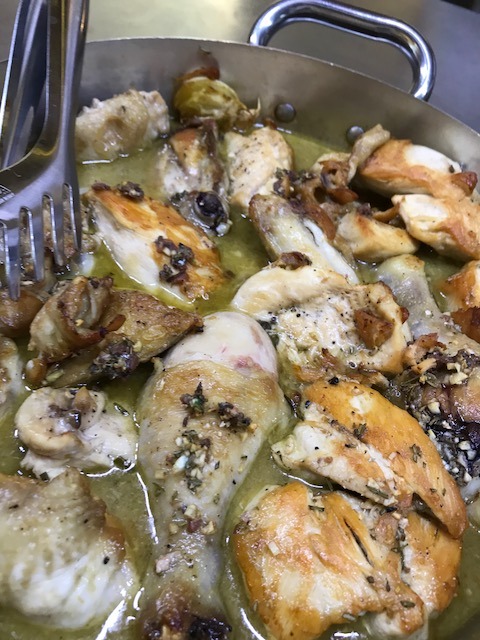


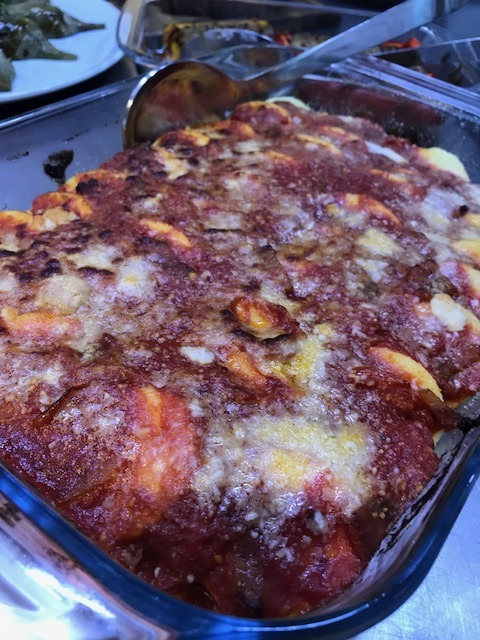
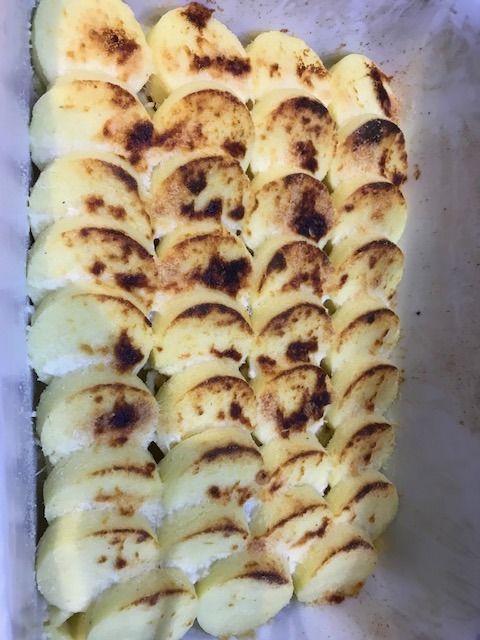
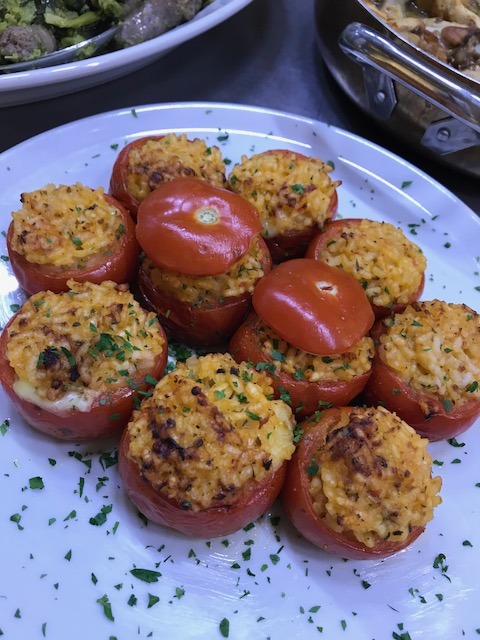
0 notes
Text
Sage and Port Sautéed Chestnuts (Vegetarian)
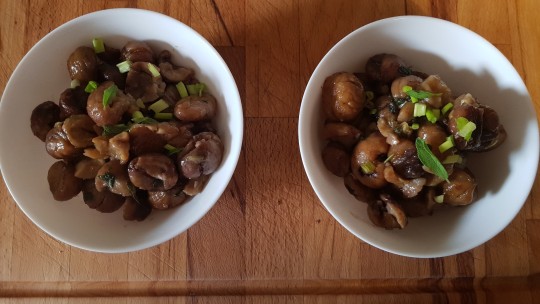
We usually eat chestnuts in the Autumn and Winter, when they are in season; even when we haven’t gone in the woods to pick them in their prickly coat! But since every time we go to the store, the cans of chestnuts are still sitting there, we just can’t help but buy a couple. And on days when the fridge and vegetable and fruit baskets are empty, it is nice to have one of those in the larder, and cook something simple but hearty and tasty, like these delicious Sage and Port Sautéed Chestnuts!
Ingredients (serves 2):
1/2 tablespoon unsalted butter
1/2 tablespoon olive oil
1 Spring onion
a bunch fresh sage
2 heaped cups cooked chestnuts (canned, bottled or sous-vide)
1/4 teaspoon coarse sea salt
1 1/2 tablespoon good quality White Port
Melt butter with olive oil in a large frying pan over medium-high heat.
Finely chop Spring onion and sage, and add to the skillet, saving a little chopped green part of the Spring onion. Cook, 1 minute, then stir in the chestnuts. Sauté, about 3 to 4 minutes, until hot, shaking the pan often. Drizzle with White Port, and cook, 1 minute more.
Serve Sage and Port Sautéed Chestnuts hot, sprinkled with chopped green part of Spring onion and small sage leaves.
#Recipe#Food#Sage and Port Sautéed Chestnuts#Sage and Port Sautéed Chestnut recipe#Chestnuts#Butter#Olive Oil#Spring Onion#Sage#Fresh Sage#Coarse Sea Salt#Port#White Port#Quick recipe#Easy recipe#5 Ingredients or Less#Larder recipe#Larder Cooking#Love Your Larder#Pantry recipe#Pantry Cooking#Thrifty#Thrifty recipe#Thrifty Thursday#Vegetarian#Vegetarian recipe#Vegetarian and Vegan
5 notes
·
View notes